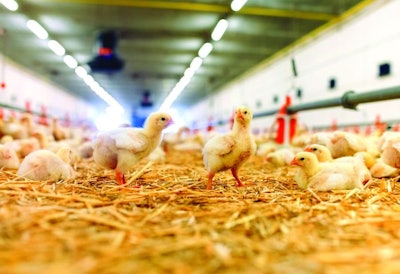
Litter is a key component of a broiler’s environment, and its quality can significantly influence performance. The availability, price and quality of litter varies from country to country and even within the same country, yet there are certain functions that any litter, irrespective of composition, must perform. When looking for a low cost, easily available bedding material there are certain questions that broiler producers should ask if they are to make the right choice.
What is the initial moisture content?
If the initial moisture content of a bedding material is too high, moisture control will never be maintained in the broiler house. Measure incoming moisture content. If bedding must be stored prior to use, ensure an appropriate, protected area is available.
Is there sufficient absorbance, wicking capability?
Bedding must have a high moisture holding capacity in order to absorb excess water, fecal material and other moisture. It must also be able to release moisture back into the environment. When bedding has limited wicking capabilities, and its moisture content rises, it will cake, due to water retention.
Excess moisture in the litter increases the incidence of breast blisters, hock burns, bruising, condemnations and downgrades. Litter moisture promotes bacterial and coccidia populations and also increases ammonia emissions, resulting in serious performance and environmental issues.
Conversely, litter that is too dry and dusty can lead to problems such as the dehydration of new chicks, respiratory disease and increased condemnations.
A good litter material should be able to absorb and release moisture into the environment as quickly as possible. In a well-managed broiler house, litter moisture normally averages 25-35%.
Does the bedding protect birds from the base floor?
Bedding should provide a protective cushion between the birds and the floor and insulate chicks from the temperature of the ground. This ensures bird comfort and promotes normal behavior.
Is the bedding non-toxic, non-poisonous to birds?
Bedding should be free of toxins, mycotoxins and contaminants, such as metals and pesticides.
When appropriate, treat new litter materials with approved anti-fungal agents. Ensure paper products do not have colored ink and that hardwood shavings have not been chemically treated.
What is the impact of particle size?
Very large and coarse bedding materials may cause conditions that downgrade carcass quality. For example, if wood chips and bark are left too large, breast blisters are a concern. Particles that are too small can lead to dust, are more likely to be eaten and can worsen respiratory problems.
The effectiveness and suitability of material may change with particle size. Pelleting or cutting cereal grain stalks to one-inch lengths improves moisture control. Paper by-products must also be sized appropriately to control moisture.
How will the external environment affect bedding?
In an arid area, a substance with less moisture control, such as sand, can be considered. In humid environments, bedding must have better moisture control. High humidity in the air reduces the ability of the bedding material to lose moisture to the environment and adversely affects poultry performance. In cooler environments, more bedding and better thermodynamic protection should be emphasized.
What are the limitations of the facilities?
The success of a bedding material will depend greatly on the conditions within the broiler house. One key component is ventilation. An efficient ventilation system will aid a bedding’s absorbance and wicking capabilities.
Another key component is the base floor type. Concrete floors reduce floor moisture, again assisting the ability of bedding to control moisture. Base floor type will also determine the depth of material needed to provide a cushion for the birds’ legs and feet and to provide sufficient thermal insulation.
How should I test materials?
Prior to implementing across houses, test material on a small scale using scientific methods.
It is important to know how a material will behave within an individual facility. Models are available to assist in comparing multiple characteristics of alternative bedding.
Can I combine materials to reduce expense?
A less than ideal material can often be mixed with more optimal substances to achieve acceptable results. As examples, paper bi-products can be mixed with other wood products, and straw works well in a 1:1 combination with shavings or rice hulls.
Is the material environmentally friendly?
When all other variables are equal, consider the cost and methods of disposal. Prioritize use of materials that are biodegradable, decompose fast and/or can be reused as a fertilizer or soil amendment.

Alternative bedding sources
Although pine (soft wood) shavings are considered the optimal bedding material, they may be difficult to obtain, especially in non-forested regions. In addition, competition with other industries for pine shavings is further reducing availability and increasing cost. Alternative, economical and environmentally-friendly sources of bedding material will continue to be needed by poultry producers.
Using the guidelines provided in this article, consider the following alternative materials.
- Hard wood shavings
- Sawdust
- Wood chips or bark
- Rice hulls
- Other food hull biproducts, e.g. cocoa, peanut, coconut and other nuts
- Some types of sand
- Dried leaves
- Maize cobs
- Chopped grass stalks, including wheat, maize, rice, barley, flax and millet
- Peat moss
- Shredded paper/ other paper by-products
- Sugar cane bagasse
- Gypsum
Litter research could boost poultry producer income, reduce carbon footprint
www.WATTAgNet.com/articles/21845
















